Chapter 8: Variation in Chromosome Structure and Number
1/251
There's no tags or description
Looks like no tags are added yet.
Name | Mastery | Learn | Test | Matching | Spaced |
|---|
No study sessions yet.
252 Terms
What is Genetic Variation?
Refers to differences between members of the same species or those of different species
What are 2 characteristics of Genetic Variation?
Allelic variations are due to differences in particular genes
Chromosomes also vary in their structure and number
What are 2 characteristics of Chromosomes?
Structure
Number
What is the Structure of Chromosomes?
Segments of chromosomes may be deleted, duplicated, and/or rearranged
What is the Number of Chromosomes?
The number of individual chromosomes may vary (e.g., 3 instead of the usual 2) or numbers of chromosome sets may vary (4 sets instead of the usual 2 sets)
What are 2 such changes of Chromosomes?
Widespread medical relevance
Agriculturally important
What is Cytogenetics?
The field of genetics that involves the microscopic examination of chromosomes
What does a Cytogeneticist typically examine?
The chromosomal composition of a particular cell or organism
Why is the benefit of Cytogeneticist examining chromosomal composition?
Allows the detection of individuals with abnormal chromosome number or structure
Provides a way to distinguish between species
True or false, Each species has a characteristic number of chromosomes?
True
What does a Micrograph of metaphase chromosomes for Human species look like?
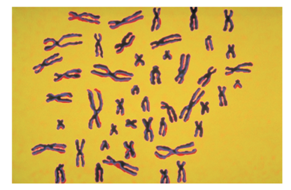
What does a Micrograph of metaphase chromosomes for Fruit Fly species look like?
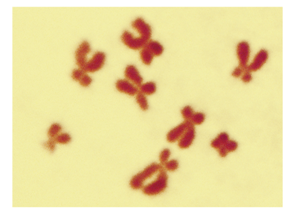
What does a Micrograph of metaphase chromosomes for Corn species look like?

What are 3 main features Cytogeneticist used to identify and classify chromosomes?
Location of the centromere
Size
Banding patterns
The location of the centromere, size and banding patterns are all seen in what?
Karyotype
What is a karyotype?
A micrograph in which all of the chromosomes within a single cell are arranged in a standard fashion
What happens when different chromosomes are very similar in size and centromere position?
Chromosomes are treated with stains to produce characteristic banding patterns
What is an example of Chromosomes treated with Stains?
G-banding
What are characteristics of G-banding?
Chromosomes are exposed to the dye Giemsa
Some regions bind the dye heavily
Some regions do not bind the dye well
Happens In humans
What is an example of Some regions bind the dye heavily?
Dark bands
What is an example of Some regions do not bind the dye well?
Light bands
How many G bands are seen in metaphase in humans?
300
How many G bands are seen in Prometaphase in humans?
800
What are 3 ways that banding pattern is useful in several ways?
It distinguishes individual chromosomes from each other
It detects changes in chromosome structure
It reveals evolutionary relationships among the chromosomes of closely related species
What does Metacentric centromic location look like?
The centromere is near the middle

What does Submetacentric centromic location look like?
The centromere is slightly off center

What does Acrocentric centromic location look like?
The centromere is significantly off center but not at the end
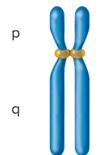
What does Telocentric centromic location look like?
Centromere is at one end

What does the Giemsa staining of human chromosomes look like?

What does the Conventional numbering system of G bands in human chromosomes look like?
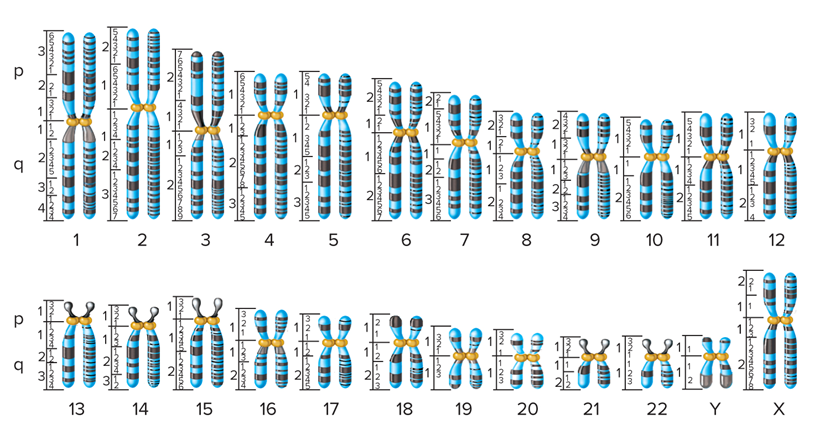
What are the 2 primary ways in which the structure of chromosomes can be altered?
The total amount of genetic material in the chromosome can change
The total amount of genetic material remains the same, but is rearranged
What are 2 examples of The total amount of genetic material in the chromosome can change?
Deletions
Duplications
What are 2 examples of the total amount of genetic material remains the same, but is rearranged?
Inversions
Translocations
What is another name for Deletion?
A deficiency (used to describe the condition of a chromosome that is missing a region)
What is Deletion?
The loss of a chromosomal segment
The affected chromosome is deficient in a significant amount of genetic material
What is Duplication?
The repetition of a chromosomal segment compared to a normal chromosome
What is Inversion?
A change in the direction of part of the genetic material along a single chromosome
What is Translocation?
A segment of one chromosome becomes attached to a different chromosome
What are 2 examples of Translocations?
Simple Translocations
Reciprocal Translocations
What is Simple Translocations?
A piece of a chromosome is attached to another chromosome
What are Reciprocal Translocations?
Two different types of chromosomes exchange pieces, producing two abnormal chromosomes with translocations
What does a Deletion look like?

What does Duplication look like?

What does Inversion look like?

What does Simple Translocation look like?

What does Reciprocal Translocation look like?

When does a chromosomal deletion occur?
When a chromosome breaks and a fragment is lost
What happens when a chromosome is broken into two pieces?
The part without the centromere is eventually lost
What does the remaining chromosome have?
A terminal deletion
What happens when a chromosome breaks into two places?
The central fragment is lost, and the two outer pieces reattach
When the chromosome breaks into 2 places, the chromosome has what?
An interstital deletion
What does a Terminal Deletion look like?

What does a Interstitial Deletion look like?

What are 2 items that phenotypic consequences depend on?
Size of deletion
Chromosomal material deleted
What happens when deletions have a phenotypic effect?
They are usually detrimental
What is an example of when deletions have a phenotypic effect, they are usually detrimental?
Cri-du-chat syndrome in humans
What causes the disease Cri-du-chat?
Caused by a deletion in the short arm of chromosome 5
What does Chromosome 5 in cri-du-chat syndrome look like?
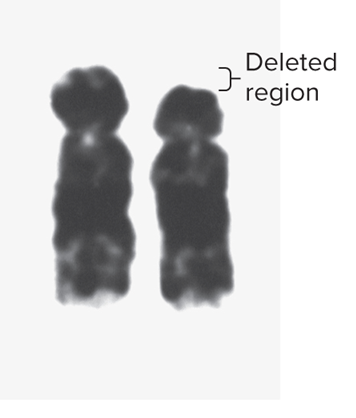
What does a child with cri-du-chat syndrome look like?
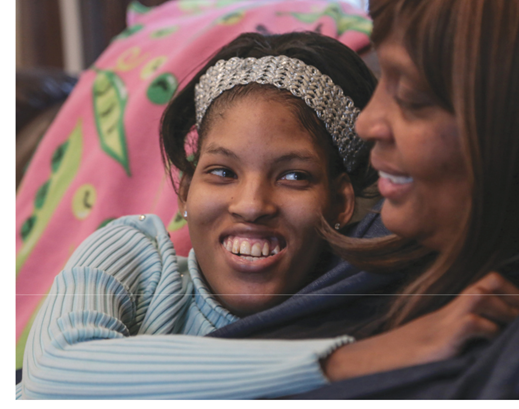
What is a chromosomal duplication usually caused by?
By abnormal events during recombination
May be caused by abnormal crossover events
What do Repetitive sequences (in red) cause?
Cause misalignment between homologous chromosomes.
What is the result of a crossover?
Nonallelic homologous recombination
What do Cross over, Repetitive sequences, Duplication and Deletion look like?
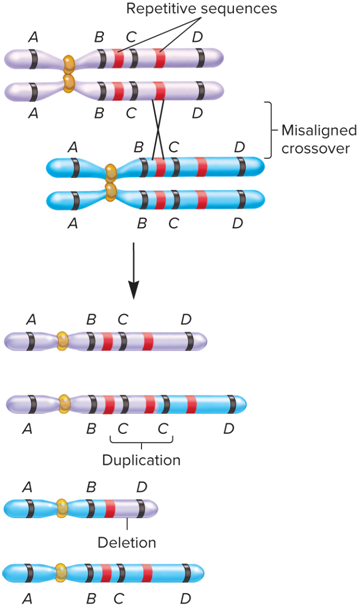
How are Duplications similar to Deletions?
The phenotypic consequences of duplications tend to be correlated to size
When do Duplications more likely to have phenotypic effects?
If they involve a large piece of the chromosome
True or false, duplications tend to have less harmful effects than deletions of comparable size?
True
In humans, relatively few well-defined syndromes are caused by?
Small chromosomal duplications
What do the majority of small chromosomal duplications have?
No phenotypic effect
Why are small chromosomal duplications vital?
They provide the raw material for the addition of genes to a species
What do small chromosomal duplications ultimately lead to?
The formation of gene families
What is a Gene Family?
Consists of two or more genes in a single species that are derived from the same ancestral gene
What happens over time when duplicated genes may accumulate mutations?
Alters their function
What is a result of duplicated genes accumulating mutations and having altered function?
They may have similar but distinct functions
Duplicated genes are now members of?
A gene family
What are Paralogs?
Homologous genes within a single species and constiute a gene family
What does Duplication genes, altered functions and Paralogs look like?

What do Globin Genes encode?
All encode subunits of proteins that bind oxygen
What happen over 500 million years to the Globin gene?
Duplicated and altered
Now 14 paralogs in this gene family on three different chromosomes
Different paralogs carry out what?
Similar but distinct functions
What does the evolution of the ancestral globin look like?
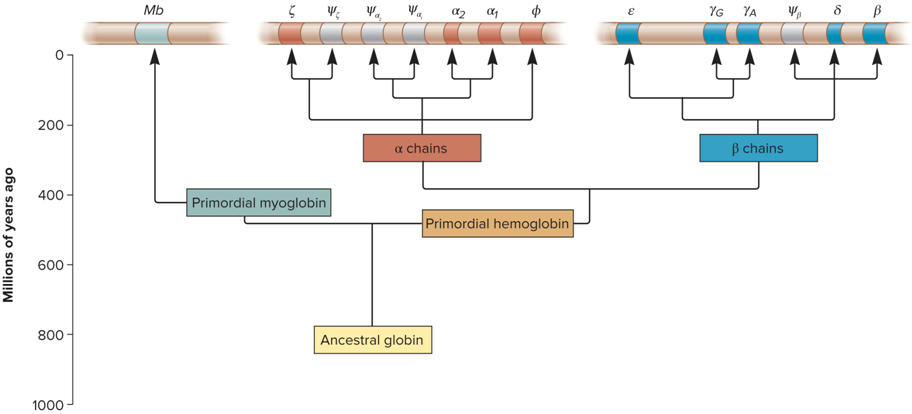
What is Copy Number Variation (CNV)?
A segment of DNA that varies in copy number among members of same species
What are some characteristics of CNV?
May be missing a particular gene
May be a duplication
Surprisingly common in animal and plants
0.1%-10% of a genome may show CNV
Human rate is approximately 0.4%
Structural variation in a segment of DNA that is 1000 bp or more
Commonly exhibits copy # differences among members of the same species
CNV occurs at population level
Is CNV relatively common?
Yes
What are possible mechanisms of CNV?
Nonallelic homologous recombination
Proliferation of transposable elements
Errors in DNA replication
CNV is associated with which human diseases?
Schizophrenia
Autism and certain learning disabilities
Susceptibility to infectious disease
Cancer
What does CNV look like?
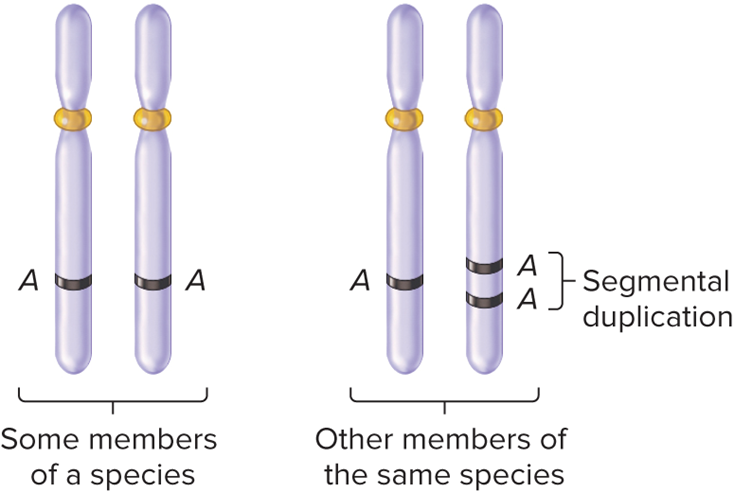
A chromosome with an inversion has what?
A segment that has been flipped to the opposite orientation
What does a Normal Chromosome look like with Inversions and Translocations?

What does a Pericentric inversion look like?
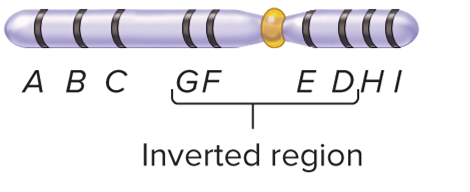
What does a Paracentric inversion look like?

What happens in an inversion?
The total amount of genetic information stays the same
The great majority of inversions have?
No phenotypic consequences
What happens in rare cases of inversions?
Inversions can alter the phenotype of an individual
What are 2 effects of Inversions?
Break point effect
Position effect
What is the Break Point Effect
An inversion break point occurs within a vital gene, thereby separating it into 2 nonfunctional parts
What is the position effect?
A gene is repositioned in a way that alters its gene expression
What is an example of the position effect?
May be placed close to regulatory elements for another gene
What percent of the human population carries inversions that are detectable with a light microscope?
2%
People who carries inversions that are detectable with a light microscope are?
Most of these individuals are phenotypically normal
What is a con of Some people who carries inversions that are detectable with a light microscope may?
Produce offspring with phenotypic abnormalities